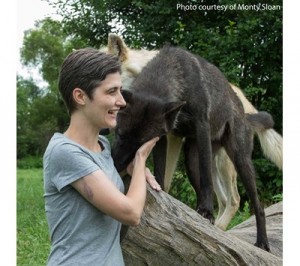Kathryn Lord’s talk focused on the comparison of the reproductive differences between the dog – Canis familiaris and its other wild relatives in the genus Canis.
The genus Canis includes six incipient (inter-fertile) species: the dog (Canis familiaris), the wolves (Canis lupus and Canis simensis), coyotes (Canis latrans), jackals (Canis aureus) and dingoes (Canis dingo). There are two other emmbers of the genus, the black-backed jackals (Canis mesomelas) and the side-striped jackals (Canis adustrus).
There are many dogs on Earth. The worldwide population of the dog is unknown and difficult to calculate. One estimate is that the ratio is 1 dog to every 10 people = 700,000,000 dogs worldwide. Some say 1 billion dogs on the planet. That’s a lot of dogs.
However, only 17% dogs considered pets, 83% of 1 billion dogs are free living animals, not under human control or human care. They’re scavengers, un-medicated, they have control over own reproduction. They are found in dumps, their natural habitat.
Seasonality
Is the tendency for sexual activity – mating and parturition to occur during certain times of the year. Males and females within a species undergo biological changes to mate only during specific times to give birth, to coincide with food availability. Adaptive animals birth during food blooms.
Domestic dogs however are NOT seasonal. Females can come into estrus approximately every 7 months while males will mate whenever. Spreading pups out through the year decreases competition for food – no seasonality is preferable
Reproduction Age & Size
Simply a byproduct of size. You need to be shape of adult to reproduce.
Smaller animals reach maturity sooner, 8kg – 15kg, can reproduce within first year.
Larger animals, 30kg – 40kg, take longer to reach maturity, so 1 to 2 years old.
Free living dogs tend to be about the same size and shape, 13kg – 15kg
Mating Strategy
Pair Bonding: Mutual protection, care for young, mating strategies.
There are two kinds of monogomy: true and social and then there is polygamy.
True monogamy happens when female truly can’t raise all her offspring on her own. Parental care is necessary in wild canis: pups can’t survive until they can hunt for themselves. Wolf pups require 24/7 care, so dad has to hunt while mom nurses. Takes a long time to succeed
Wild canis tend to be monogamous. Not enough studies (except on Ethiopian wolf) to determine if social vs true monogamy. Some coyotes are truly monogamous.
Social monogamy: “don’t put all your eggs in one basket”. Ethiopian wolves socially monogamous.
Dump dogs: completely promiscuous and polygamous. No monogamy at all.
Regurgitation & Provisioning
Regurgitation very effective way to provide for offspring without theft from other animals
Regurgitation vs. provisioning because you can hide your food better. Chunk of meat can get stolen. Not if it’s in your tummy!
Bringing back meat can leave you open to scavengers stealing. Regurgitation is less able to be scavenged
Sibling Care
Help each other in good year, compete in bad years. Older siblings prioritized because closer to reproductive age.
It´s advantageous to help raising your brothers and sisters because they share some same genes as yours.
Wolves practice sibling care as well as parental care. Help your genes go forward…unless it’s a lean year, then steal!
Don’t want to share your already-eaten steak dinner? Put your face in the air and don’t let the pups lick you!
Dogs (Canis familiaris)
Dogs: indiscriminate breeders, lousy parents, opportunists.
Dogs outside human control developed improved parental skill – evolved for new environment
Dogs in dump don’t have to hunt. They can survive on their own long before adulthood. Less parental care needed
Living off human garbage is the ecological niche dogs, as a species, have adapted for – allowing them to reproduce & grow.
You can see more info here: http://www.researchgate.net/publication/232812626_Variation_in_reproductive_traits_of_members_of_the_genus_Canis_with_special_attention_to_the_domestic_dog_(Canis_familiaris)




